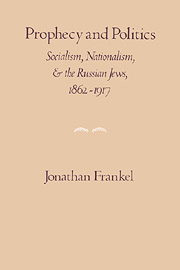Book contents
- Frontmatter
- Contents
- Preface
- Glossary
- Introduction
- Part I The preparty stage
- Part II The party ideologies until 1907
- 3 The politics of Jewish liberation, 1905–1906
- 4 The Bund: between nation and class
- 5 Chaim Zhitlovsky: Russian populist and Jewish socialist, 1887–1907
- 6 Nachman Syrkin: On the populist and prophetic strands in socialist Zionism, 1882–1907
- 7 Ber Borochov and Marxist Zionism, 1903–1907
- Part III Ideology and émigré realities
- Note: The American Jewish Congress and Russian Jewry, 1915–1919
- Conclusion
- Notes
- Bibliography
- Index
3 - The politics of Jewish liberation, 1905–1906
Published online by Cambridge University Press: 28 October 2009
- Frontmatter
- Contents
- Preface
- Glossary
- Introduction
- Part I The preparty stage
- Part II The party ideologies until 1907
- 3 The politics of Jewish liberation, 1905–1906
- 4 The Bund: between nation and class
- 5 Chaim Zhitlovsky: Russian populist and Jewish socialist, 1887–1907
- 6 Nachman Syrkin: On the populist and prophetic strands in socialist Zionism, 1882–1907
- 7 Ber Borochov and Marxist Zionism, 1903–1907
- Part III Ideology and émigré realities
- Note: The American Jewish Congress and Russian Jewry, 1915–1919
- Conclusion
- Notes
- Bibliography
- Index
Summary
The pull of the revolution: 1881–1882 and 1905–1906
“I do not know how others number the years. But I count them from 1905”. This was the opening line of a prose poem written in 1936 by Dovid Einhorn (then in Paris) in tribute to his friend Borekh Vladeck (then in New York). Born in White Russia in the same year, 1886, these two men had been less than twenty when the revolution began. But this did not prevent them (both members of the Bund) from reaching a very considerable measure of fame in the period 1905–6, the one as a poet, the other as an orator of the revolution. Extreme youth became, if anything, an asset in these years when natural talent, however untutored and be it organizational, intellectual, oratorical, or literary, was suddenly in enormous demand.
“We are now living through a Sturm und Drang period”, Iulii Brutskus wrote in March 1906, “similar to that experienced by the German Jews one hundred years ago in the time of the French Revolution and Napoleon I”. Born in 1870, Brutskus belonged to an earlier generation than Vladeck and Einhorn. Moreover, he was not a socialist but since his student days had been Palestine-oriented, first as a Hovev-Zion and then as a Zionist.
- Type
- Chapter
- Information
- Prophecy and PoliticsSocialism, Nationalism, and the Russian Jews, 1862-1917, pp. 134 - 170Publisher: Cambridge University PressPrint publication year: 1981



